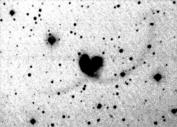 Detail
from image above shows the faint "antennae" of this pair
Detail
from image above shows the faint "antennae" of this pair
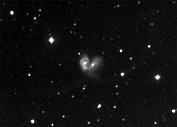 NGC4038/39,
Famous group of merging galaxies in Corvus, 8inch f/4.6, 05/16/99, jpeg 22k
NGC4038/39,
Famous group of merging galaxies in Corvus, 8inch f/4.6, 05/16/99, jpeg 22k
This interacting pair of galaxies is called "The Antennae". It is so
named because a pair of long tails of luminous matter, formed by the
gravitational tidal forces of their encounter, resembles an insect's
antennae. The galaxies are located 63 million light-years away in the constellation
Corvus. They are always too far south to be imaged from my home site. So
it was quite clear, that this exiting object was one of my first targets,
when I stayed in France, in May 99. Although the galaxies were not in the
best position above the horizon, I was astonished to see so much detail
and structure. It seems that my new, self build Newtonian is a sharp telescope.
Of course I was not sure whether the antennae would come into view, but
the night was good and you can see the result in the next image. This pair
is also cataloged as Arp 244.
 Detail
from image above shows the faint "antennae" of this pair
Detail
from image above shows the faint "antennae" of this pair
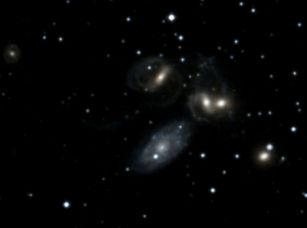 Stephan's Quintet, Compact group of galaxies in Pegasus, Meade 14inch f/10, 10/10/2010, jpeg,
35k
Stephan's Quintet, Compact group of galaxies in Pegasus, Meade 14inch f/10, 10/10/2010, jpeg,
35k
Five closely grouped galaxies are visible in this image. The grouping
is commonly known as Stephan's Quintet. Four of the galaxies
show essentially the same redshift suggesting that they are at the
same distance from us. The large spiral below and right of the center actually
has a smaller redshift than the others, indicating it is much closer. It
is probably a foreground object which happens to lie along the line of
sight to the more distant galaxies. Alternate names: NGC 7317, 7318B , 7318A, 7319, 7320, UGC 12100 MCG 6-49-
40 CGCG 514- 62 HICK 92B ARP 319 ?
VV 288 ?
The next image was made with the new ST8E-camera (1999). It provides a much larger field of view due to the large CCD, so it was possible to get M81 and M82 into the same frame.
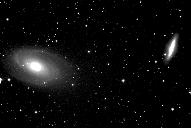 M81,
M82, Group of galaxies in Ursa Major, 8inch f/4.6, ST8-E, 01/11/00, jpeg 43k
M81,
M82, Group of galaxies in Ursa Major, 8inch f/4.6, ST8-E, 01/11/00, jpeg 43k
At a distance of 3.6 Mpc, the M81 is the next to our own Local Group of galaxies. It consists of several more members.wich are wide spread across the nothern sky. The next image shows HolmbergIX, a faint, close companion of M81. The image is enlarged from the one above.
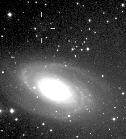 Holmberg
IX, Fait companion of M81, jpeg 25k
Holmberg
IX, Fait companion of M81, jpeg 25k
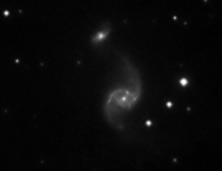 Arp
82 = NGC 2535/36, colliding galaxies in Cancer ca. 220 million
lightyears away. NGC 2535 has a
bright oval of star formation, perhaps even formation of new globular
clusters is visible, 10inch f/4.6, 03/21/03, jpeg 180k, 5 images of
200sek exp.-time.
Interesting facts and images of Arp 82 from far UV to deep infrared, made by the GALEX ( Galaxy Evolution Explorer) and Spitzer space telescopes on this website
Arp
82 = NGC 2535/36, colliding galaxies in Cancer ca. 220 million
lightyears away. NGC 2535 has a
bright oval of star formation, perhaps even formation of new globular
clusters is visible, 10inch f/4.6, 03/21/03, jpeg 180k, 5 images of
200sek exp.-time.
Interesting facts and images of Arp 82 from far UV to deep infrared, made by the GALEX ( Galaxy Evolution Explorer) and Spitzer space telescopes on this website
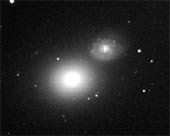 M60 and NGC4647 a close pair in Virgo, 10inch f/4.6, SBig ST-8e.
Five images of 200 sec. were combined. 03/27/03, jpeg, 178k
M60 and NGC4647 a close pair in Virgo, 10inch f/4.6, SBig ST-8e.
Five images of 200 sec. were combined. 03/27/03, jpeg, 178k
Also visible in the full image are M59 (right), NGC4638 (middle) and several background galaxies.
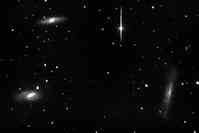 M66,
M65 and NGC 3628, Leo's triplet, 8inch f/4.6, SBig ST8e, 01/28/00, jpeg 14k
M66,
M65 and NGC 3628, Leo's triplet, 8inch f/4.6, SBig ST8e, 01/28/00, jpeg 14k
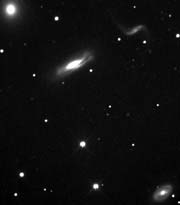 NGC
3190 (center)/85/87/93, Group of galaxies in Leo, 10inch f/4.6,
ST-8E, 03/19/03, jpeg, 110k
NGC
3190 (center)/85/87/93, Group of galaxies in Leo, 10inch f/4.6,
ST-8E, 03/19/03, jpeg, 110k
This group is also known as Hickson 44.
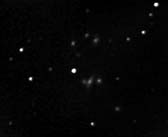 NGC
3745 /46/48/50/51/53/54, Copeland's Septet,Group of galaxies in Leo, 04/16/99,jpeg,10k
NGC
3745 /46/48/50/51/53/54, Copeland's Septet,Group of galaxies in Leo, 04/16/99,jpeg,10k
For a better designation look at this finder
chart.
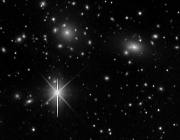 Center
of the huge Coma Cluster of Galaxies, 04/05/03, jpeg, 176k
Center
of the huge Coma Cluster of Galaxies, 04/05/03, jpeg, 176k
Almost every object in the above image is a galaxy. The Coma Cluster
of Galaxies is one of the densest clusters known - it contains thousands
of galaxies, where each of these galaxies contains billions of stars. Most
galaxies in Coma and other clusters are ellipticals, while galaxies
outside of clusters are dominated by spiral forms. The nature of Coma's
X-ray emission is still being investigated.
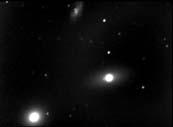 M105,NGC
3389/84 (left to right), Group of galaxies in Leo, CG11 f/6.3, 03/11/99, jpeg,
14k
M105,NGC
3389/84 (left to right), Group of galaxies in Leo, CG11 f/6.3, 03/11/99, jpeg,
14k
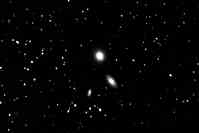 NGC
3389, M105, NGC 3384, Group of galaxies in Leo, 8inch f/4.6, ST8E, 01/28/00,
jpeg 12k
NGC
3389, M105, NGC 3384, Group of galaxies in Leo, 8inch f/4.6, ST8E, 01/28/00,
jpeg 12k
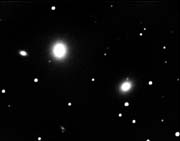 NGC
3605/07/08, Group of galaxies in Leo, 03/11/99, jpeg, 12k
NGC
3605/07/08, Group of galaxies in Leo, 03/11/99, jpeg, 12k
There is another small uncataloged galaxy near the bottom of this image.
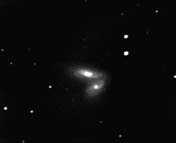 NGC
4567/68 (bottom/top), The "Siamese Twins", group of galaxies in Virgo,03/11/99,jpeg,
6k
NGC
4567/68 (bottom/top), The "Siamese Twins", group of galaxies in Virgo,03/11/99,jpeg,
6k
I have made a drawing
of this group in 1997, while I stayed on La Palma island for holidays.
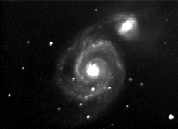 M51 and NGC 5195, Interacting galaxies in Canes Venatici, jpeg, 19k
M51 and NGC 5195, Interacting galaxies in Canes Venatici, jpeg, 19k
Together with several fainter examples they form the M51 group.
There is also a drawing of these galaxies
from
1997.
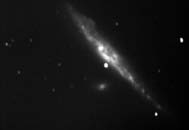 NGC
4631 and small companion NGC 4627, Pair in Canes Venatici,12/17/98,jpeg,12k
NGC
4631 and small companion NGC 4627, Pair in Canes Venatici,12/17/98,jpeg,12k
It seems, that this large edge-on galaxy forms an interacting pair with NGC 4656 (not seen in this image).
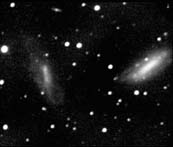 NGC
672 (right), IC 1727 and an uncataloged background galaxy in Triangulum,
12/17/98, jpeg, 33k
NGC
672 (right), IC 1727 and an uncataloged background galaxy in Triangulum,
12/17/98, jpeg, 33k
The following images are from July 30, 1998. Good, clear summer sky.
The images of NGC 7479, 7814, 7385 are single shots of 100 second integration
time. All others were made with 1 min exp. time. Five darks of 120 seconds
and a flat field (average of 7 images) were used in all cases.
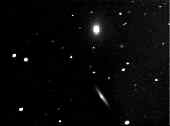 NGC 5981/82, Small group in Draco, 07/30/98, jpeg, 17k
NGC 5981/82, Small group in Draco, 07/30/98, jpeg, 17k
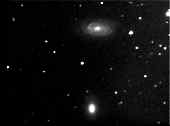 NGC 5985/82, Small group in Draco, 07/30/98, jpeg, 17k
NGC 5985/82, Small group in Draco, 07/30/98, jpeg, 17k
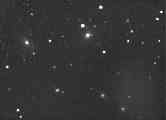 NGC 7385..., Cluster of galaxies in Pegasus, 07/30/98, jpeg, 22k
NGC 7385..., Cluster of galaxies in Pegasus, 07/30/98, jpeg, 22k
Galaxy NGC 7387, located at PA200 relative to brightest
NGC7385, has highest (in my collection)
RV relative to the Local Group: 9909.512 km/second
so
far.
NGC 7385, Right ascension: 22h49m54.66s, Declination:
+11 36' 31.7"
Remarks from the PGC (Principal Galaxy Catalog): PGC
069824
Effective surface brightness: 22.664 ñ .434 (magnitudes
per square arcsecond)
Total B magnitude: 13.242 ñ .282
Galaxy RV relative to the Local Group: 8071.292 km/second
Major axis: 1.355ñ0.349 arcminutes
Alternate names:NGC 7385
UGC 12207 MCG 2-58- 17
CGCG 430- 15
The following images are from August 14, 1998.
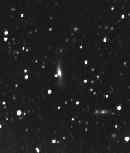 Group of far away galaxies around NGC 6928 in Delphinus, 08/14/98, jpeg,
11k
Group of far away galaxies around NGC 6928 in Delphinus, 08/14/98, jpeg,
11k
NGC 6928, Right ascension: 20h32m49.63s, Declination:
+09 55' 45.5"
Remarks from the PGC (Principal Galaxy Catalog): PGC
064932
Effective surface brightness: 21.932 ñ .490 (magnitudes
per square arcsecond)
Total B magnitude: 13.232 ñ .180, Far infrared
magnitude: 12.194
Galaxy RV relative to the Local Group: 4904.870 km/second
Major axis: 2.075ñ0.210 arcminutes
Alternate names: NGC 6928
UGC 11589 MCG 2-52- 17 CGCG 424-
21 IRAS20304+0945
The following image is from August 19, 1998.
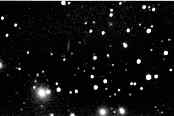 Arp 331 , Distant chain of elliptical galaxies in Pisces, 08/19/98, jpeg,
19k
Arp 331 , Distant chain of elliptical galaxies in Pisces, 08/19/98, jpeg,
19k
with 16.6mag UGC 679 left of center
NGC 383 (brightest G, lower left) Right ascension: 01h07m25.14s,Declination:
+32 24' 46.5"
Remarks from the PGC (Principal Galaxy Catalog):PGC 003982
Effective surface brightness: 21.333 ñ .490 (magnitudes
per square arcsecond)
Total B magnitude: 13.161 ñ .268
Galaxy RV relative to the Local Group: 5244.295 km/second
Major axis: 2.128ñ0.250 arcminutes
Alternate names: NGC 383
UGC 689 MCG 5- 3- 53
CGCG 501- 87 ARP 331 ? KCPG
23B VV 193 ? 4ZW
38 ?
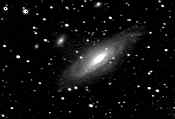 NGC 7331, Group of galaxies in Pegasus, 08/19/98, jpeg, 18k
NGC 7331, Group of galaxies in Pegasus, 08/19/98, jpeg, 18k
The following images are from December 17, 1998.
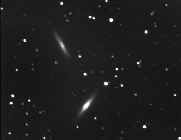 NGC 7332 and NGC
7339, Group of galaxies in Pegasus, 12/17/98, jpeg, 20k
NGC 7332 and NGC
7339, Group of galaxies in Pegasus, 12/17/98, jpeg, 20k
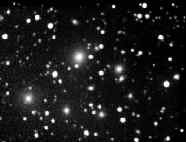 NGC 1275 and many
others, Cluster of galaxies in Perseus, 12/17/98, jpeg, 23k
NGC 1275 and many
others, Cluster of galaxies in Perseus, 12/17/98, jpeg, 23k
NGC1275, Right ascension: 03h19m48.50s, Declination: +41
30' 45.0"
Remarks from the PGC (Principal Galaxy Catalog): PGC
012429
Effective surface brightness: 20.745 ñ .490 (magnitudes
per square arcsecond)
Total B magnitude: 12.485 ñ .191,Far infrared
magnitude: 11.183
Galaxy RV relative to the Local Group: 5476.540 km/second
Major axis: 2.570ñ0.681 arcminutes
Alternate names: NGC 1275
UGC 2669 MCG 7- 7- 63 CGCG
540-103 IRAS03164+4119
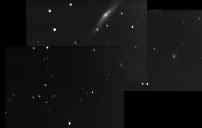 Mosaic, NGC 3079,
NGC 3073 and the gravitational lens Q0957+561A/B,
group of galaxies in Ursa Major, 12/17/98, jpeg, 5k
Mosaic, NGC 3079,
NGC 3073 and the gravitational lens Q0957+561A/B,
group of galaxies in Ursa Major, 12/17/98, jpeg, 5k
Right ascension: 10h01m58.18s, Declination: +55 40' 42.7"
Remarks from the PGC (Principal Galaxy Catalog): PGC
029050
Effective surface brightness: 21.166 ñ .490 (magnitudes
per square arcsecond)
Total B magnitude: 11.265 ñ .328, Far infrared
magnitude: 9.000
Heliocentric galaxy RV from neutral hydrogen: 1120.759
ñ 8.652 km/s
Heliocentric galaxy RV from optical observations: 1101.265
ñ 79.885 km/s
Galaxy RV relative to the Local Group: 1215.221 km/second
Major axis: 8.128ñ0.337 arcminutes
Alternate names: NGC 3079
UGC 5387
MCG 9-17- 10 CGCG 266- 8
IRAS09585+5555
Compare the image above with a x-ray ROSAT
image of the same region.
( Abstract and Image from W.Pietsch,
G.Trinchieri, and A.Vogler, NGC 3079: X-ray emission from the nuclear
super-bubble and halo, Astronomy and Astrophysics 340, 351-370(1998).
Comments welcome, contact:
